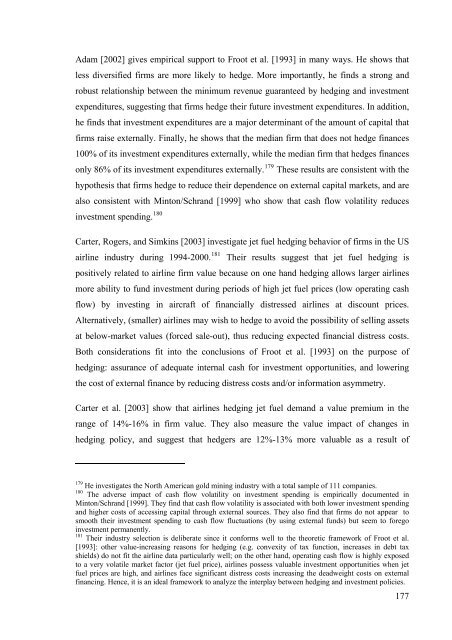értekezés - Budapesti Corvinus Egyetem
értekezés - Budapesti Corvinus Egyetem
értekezés - Budapesti Corvinus Egyetem
Create successful ePaper yourself
Turn your PDF publications into a flip-book with our unique Google optimized e-Paper software.
Adam [2002] gives empirical support to Froot et al. [1993] in many ways. He shows that<br />
less diversified firms are more likely to hedge. More importantly, he finds a strong and<br />
robust relationship between the minimum revenue guaranteed by hedging and investment<br />
expenditures, suggesting that firms hedge their future investment expenditures. In addition,<br />
he finds that investment expenditures are a major determinant of the amount of capital that<br />
firms raise externally. Finally, he shows that the median firm that does not hedge finances<br />
100% of its investment expenditures externally, while the median firm that hedges finances<br />
only 86% of its investment expenditures externally. 179 These results are consistent with the<br />
hypothesis that firms hedge to reduce their dependence on external capital markets, and are<br />
also consistent with Minton/Schrand [1999] who show that cash flow volatility reduces<br />
investment spending. 180<br />
Carter, Rogers, and Simkins [2003] investigate jet fuel hedging behavior of firms in the US<br />
airline industry during 1994-2000. 181 Their results suggest that jet fuel hedging is<br />
positively related to airline firm value because on one hand hedging allows larger airlines<br />
more ability to fund investment during periods of high jet fuel prices (low operating cash<br />
flow) by investing in aircraft of financially distressed airlines at discount prices.<br />
Alternatively, (smaller) airlines may wish to hedge to avoid the possibility of selling assets<br />
at below-market values (forced sale-out), thus reducing expected financial distress costs.<br />
Both considerations fit into the conclusions of Froot et al. [1993] on the purpose of<br />
hedging: assurance of adequate internal cash for investment opportunities, and lowering<br />
the cost of external finance by reducing distress costs and/or information asymmetry.<br />
Carter et al. [2003] show that airlines hedging jet fuel demand a value premium in the<br />
range of 14%-16% in firm value. They also measure the value impact of changes in<br />
hedging policy, and suggest that hedgers are 12%-13% more valuable as a result of<br />
179 He investigates the North American gold mining industry with a total sample of 111 companies.<br />
180 The adverse impact of cash flow volatility on investment spending is empirically documented in<br />
Minton/Schrand [1999]. They find that cash flow volatility is associated with both lower investment spending<br />
and higher costs of accessing capital through external sources. They also find that firms do not appear to<br />
smooth their investment spending to cash flow fluctuations (by using external funds) but seem to forego<br />
investment permanently.<br />
181 Their industry selection is deliberate since it conforms well to the theoretic framework of Froot et al.<br />
[1993]: other value-increasing reasons for hedging (e.g. convexity of tax function, increases in debt tax<br />
shields) do not fit the airline data particularly well; on the other hand, operating cash flow is highly exposed<br />
to a very volatile market factor (jet fuel price), airlines possess valuable investment opportunities when jet<br />
fuel prices are high, and airlines face significant distress costs increasing the deadweight costs on external<br />
financing. Hence, it is an ideal framework to analyze the interplay between hedging and investment policies.<br />
177
















